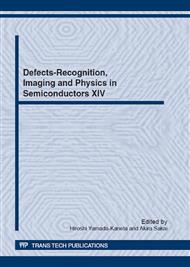[1]
J. Martin, C. Fernandez-Alonso, J.A. Poce-Fatou, R. Alcantara, A versatile computer-controlled high-resolution LBIC system, Prog. Photovolt: Res. Appl. 12 (2004) 283-295
DOI: 10.1002/pip.528
Google Scholar
[2]
O. Breitenstein, W. Warta, M. Langenkamp, Lock-in Thermography - Basics and Use for Evaluating Electronic Devices and Materials, second ed., Springer, Berlin/Heidelberg, (2010)
DOI: 10.1007/978-3-642-02417-7
Google Scholar
[3]
Information on www.thermosensorik.com
Google Scholar
[4]
Information on http://dcgsystems.com
Google Scholar
[5]
Information on www.infratec.de
Google Scholar
[6]
Information on www.automationtechnology.de
Google Scholar
[7]
T. Trupke, R.A. Bardos, M.C. Schubert, W. Warta, Photoluminescence imaging of silicon wafers, Appl. Phys. Lett. 89 (2006) 044107
DOI: 10.1063/1.2234747
Google Scholar
[8]
T. Fuyuki, H. Kondo, T. Yamazaki, Y. Takahashi, Y. Uraoka, Photographic surveying of minority carrier diffusion length in polycrystalline silicon solar cells by electroluminescence, Appl. Phys. Lett. 86 (2005) 262108
DOI: 10.1063/1.1978979
Google Scholar
[9]
O. Breitenstein, J. Bauer, K. Bothe, D. Hinken, J. Müller, W. Kwapil, M.C. Schubert, W. Warta, Can luminescence imaging replace lock-in thermography on solar cells?, contribution at 37th IEEE PVSC, Seattle 2011, to be published in IEEE J-PV
DOI: 10.1109/pvsc.2011.6185846
Google Scholar
[10]
A. Simo, S. Martinuzzi, Hot spots and heavily dislocated regions in multicrystalline silicon cells, 21st IEEE Photovoltaic Specialists Conference, Kissimee 1990, pp.800-805
DOI: 10.1109/pvsc.1990.111730
Google Scholar
[11]
J. Wohlgemuth, W. Herrmann, Hot spot tests for crystalline silicon modules, 31st IEEE Photovoltaic Specialists Conference, Orlando 2005, pp.1062-1063
DOI: 10.1109/pvsc.2005.1488317
Google Scholar
[12]
P.K. Kuo, T. Ahmed, H. Jin, R.L. Thomas, Phase-locked image acquisition in thermography, SPIE 1004 (1988) 41-45
Google Scholar
[13]
X.P.V. Maldague, Theory and practice of infrared technology for nondestructive testing, Wiley, New York, 2001.
Google Scholar
[14]
O. Breitenstein, J.P. Rakotoniaina, M.H. Al Rifai, Quantitative Evaluation of Shunts in Solar Cells by Lock-in Thermography, Prog. Photovolt: Res. Appl. 11 (2003) 515-526
DOI: 10.1002/pip.520
Google Scholar
[15]
K. Ramspeck, K. Bothe, D. Hinken, B. Fischer, J. Schmidt, R. Brendel, Recombination current and series resistance imaging of solar cells by combined luminescence and lock-in thermography, Appl. Phys. Lett 90 (2007) 153502
DOI: 10.1063/1.2721138
Google Scholar
[16]
O. Breitenstein, Nondestructive local analysis of current-voltage characteristics of solar cells by lock-in thermography, Solar Energy Mat. & Solar Cells 95 (2011) 2933-2936
DOI: 10.1016/j.solmat.2011.05.049
Google Scholar
[17]
S. Ostapenko, I. Tarasov, J.O. Kalejs, C. Haessler, E-U. Reisner, Defect monitoring using scanning photoluminescence spectroscopy in multicrystalline silicon wafers, Semicond. Sci. Technol. 15 (2000) 840-848.
DOI: 10.1088/0268-1242/15/8/310
Google Scholar
[18]
T. Trupke, R.A. Bardos, M.C. Schubert, W. Warta, Photoluminescence imaging of silicon wafers, Appl. Phys. Lett. 89 (2006) 044107
DOI: 10.1063/1.2234747
Google Scholar
[19]
T. Fuyuki, H. Kondo, T. Yamazaki, Y. Takahashi, Y. Uraoka, Photographic surveying of minority carrier diffusion length in polycrystalline silicon solar cells by electroluminescence, Appl. Phys. Lett. 86 (2005) 262108
DOI: 10.1063/1.1978979
Google Scholar
[20]
T. Trupke, E. Pink, R. A. Bardos, M. D. Abbott, Spatially resolved series resistance of silicon solar cells obtained from luminescence imaging, Appl. Phys. Lett. 90 (2007) 093506
DOI: 10.1063/1.2709630
Google Scholar
[21]
M. Glatthaar, J. Haunschild, M. Kasemann, J. Giesecke, W. Warta, Spatially resolved determination of dark saturation current and series resistance of silicon solar cells, Phys. Stat. Sol. RRL 4 (2010) 13-15
DOI: 10.1002/pssr.200903290
Google Scholar
[22]
J. Haunschild, M. Glatthaar, M. Kasemann, S. Rein, E.R. Weber, Fast series resistance imaging for silicon solar cells using electroluminescence, Phys. Stat. Sol. RRL 3 (2009) 227-229
DOI: 10.1002/pssr.200903175
Google Scholar
[23]
O. Breitenstein, A. Khanna, Y. Augarten, J. Bauer, J.-M. Wagner, K. Iwig, Quantitative evaluation of electroluminescence images of solar cells, Phys. Stat. Sol. RRL 4 (2010) 7-9
DOI: 10.1002/pssr.200903304
Google Scholar
[24]
S. Herlufsen, J. Schmidt, D. Hinken, K. Bothe, R. Brendel, Photoconductance-calibrated photoluminescence lifetime imaging of crystalline silicon, Phys. Stat. Sol. (RRL) 2 (2008) 245-247
DOI: 10.1002/pssr.200802192
Google Scholar
[25]
S. Herlufsen, K. Ramspeck, D. Hinken, A. Schmidt, J. Müller, K. Bothe, J. Schmidt, R. Brendel, Dynamic photoluminescence lifetime imaging for the characterization of silicon wafers, Phys. Stat. Sol. (RRL) 5 (2011) 25–27
DOI: 10.1002/pssr.201004426
Google Scholar
[26]
S. Steingrube, O. Breitenstein, K. Ramspeck, S. Glunz, A. Schenk, P.P. Altermatt, Explanation of commonly observed shunt currents in c-Si solar cells by means of recombination statistics beyond the Shockley-Read-Hall approximation, J. Appl. Phys. 110 (2011) 014515
DOI: 10.1063/1.3607310
Google Scholar
[27]
O. Breitenstein, J. Bauer, T. Trupke, R.A. Bardos, On the detection of shunts in silicon solar cells by photo- and electroluminescence imaging, Prog. Photovolt: Res. Appl. 16 (2008) 325-330
DOI: 10.1002/pip.803
Google Scholar
[28]
K. Ramspeck, K. Bothe, D. Hinken, B. Fischer, J. Schmidt, R. Brendel, Recombination current and series resistance imaging of solar cells by combined luminescence and lock-in thermography, Appl. Phys. Lett. 90 (2007) 153502
DOI: 10.1063/1.2721138
Google Scholar


